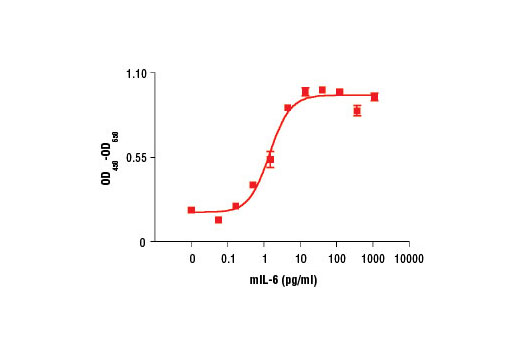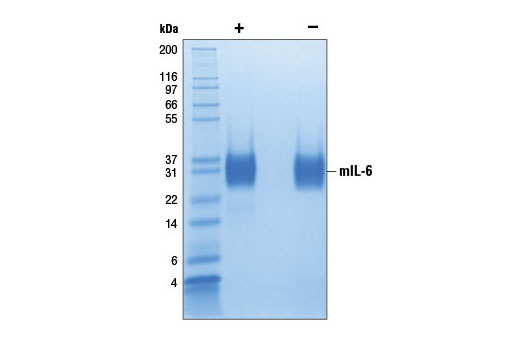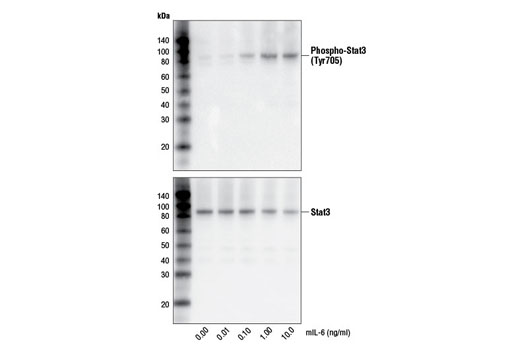26-36
#P08505
16193
Background
IL-6 is a potent inducer of the acute phase response and is produced by T cells, macrophages, fibroblasts, endothelial, and other cells (1,2). IL-6 induces proliferation and differentiation and acts on B cells, T cells, thymocytes, and others. IL-6 in concert with TGFβ is important for developing Th17 responses. IL-6 binds to IL-6Rα and through this association induces gp130 homodimerization (1). gp130 homodimerization triggers the Jak/Stat cascade and the SHP2/MAPK (Erk) cascade (1,3,4). IL-6 also forms a complex with an IL-6Rα splice variant that is non-membrane associated (3).The IL-6/soluble IL-6Rα complex can then activate the gp130 signaling pathway on cells that express gp130 but not IL-6Rα (3). IL-6, through increasing expression of proangiogenic VEGF, may contribute to metastatic breast cancer (5).
Endotoxin
Less than 0.01 ng endotoxin/1 μg mIL-6.
Purity
>98% as determined by SDS-PAGE of 6 μg reduced (+) and non-reduced (-) recombinant mIL-6. All lots are greater than 98% pure.
Source / Purification
Recombinant mouse IL-6 (mIL-6) Phe25-Thr211 (Accession #NP_112445) was expressed in human 293 cells at Cell Signaling Technology.
Bioactivity
The bioactivity of recombinant mIL-6 was determined in a B9 cell proliferation assay. The ED50 of each lot is between 0.5 and 20 pg/ml.
Background
IL-6 is a potent inducer of the acute phase response and is produced by T cells, macrophages, fibroblasts, endothelial, and other cells (1,2). IL-6 induces proliferation and differentiation and acts on B cells, T cells, thymocytes, and others. IL-6 in concert with TGFβ is important for developing Th17 responses. IL-6 binds to IL-6Rα and through this association induces gp130 homodimerization (1). gp130 homodimerization triggers the Jak/Stat cascade and the SHP2/MAPK (Erk) cascade (1,3,4). IL-6 also forms a complex with an IL-6Rα splice variant that is non-membrane associated (3).The IL-6/soluble IL-6Rα complex can then activate the gp130 signaling pathway on cells that express gp130 but not IL-6Rα (3). IL-6, through increasing expression of proangiogenic VEGF, may contribute to metastatic breast cancer (5).
Background References
Cross-Reactivity Key
H: human M: mouse R: rat Hm: hamster Mk: monkey Vir: virus Mi: mink C: chicken Dm: D. melanogaster X: Xenopus Z: zebrafish B: bovine Dg: dog Pg: pig Sc: S. cerevisiae Ce: C. elegans Hr: horse GP: Guinea Pig Rab: rabbit All: all species expected
Trademarks and Patents
Limited Uses
Except as otherwise expressly agreed in a writing signed by a legally authorized representative of CST, the following terms apply to Products provided by CST, its affiliates or its distributors. Any Customer's terms and conditions that are in addition to, or different from, those contained herein, unless separately accepted in writing by a legally authorized representative of CST, are rejected and are of no force or effect.
Products are labeled with For Research Use Only or a similar labeling statement and have not been approved, cleared, or licensed by the FDA or other regulatory foreign or domestic entity, for any purpose. Customer shall not use any Product for any diagnostic or therapeutic purpose, or otherwise in any manner that conflicts with its labeling statement. Products sold or licensed by CST are provided for Customer as the end-user and solely for research and development uses. Any use of Product for diagnostic, prophylactic or therapeutic purposes, or any purchase of Product for resale (alone or as a component) or other commercial purpose, requires a separate license from CST. Customer shall (a) not sell, license, loan, donate or otherwise transfer or make available any Product to any third party, whether alone or in combination with other materials, or use the Products to manufacture any commercial products, (b) not copy, modify, reverse engineer, decompile, disassemble or otherwise attempt to discover the underlying structure or technology of the Products, or use the Products for the purpose of developing any products or services that would compete with CST products or services, (c) not alter or remove from the Products any trademarks, trade names, logos, patent or copyright notices or markings, (d) use the Products solely in accordance with CST Product Terms of Sale and any applicable documentation, and (e) comply with any license, terms of service or similar agreement with respect to any third party products or services used by Customer in connection with the Products.


